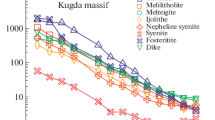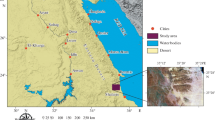Abstract
Rare-element pegmatites in the Voron’i tundras, Kola Peninsula, Russia, contain late abundant Rb mineralization. Individual Rb minerals are Rb-dominant feldspars and micas that form continuous solid solution series with K analoques. The feldspars contain from 17 to 86 mol % RbAlSi3O8 (5.5–25 wt % Rb2O) and 1–5 mol % CsAlSi3O8, and the muscovite contains 2.6–9.4 wt % Rb2O. The Li micas are members of the lepidolite-polylithionite series and their Rb-dominant analogues. They form a continuous series of solid solutions with the Rb concentrations varying from 0.09 to 0.54 apfu., K concentrations varying from 0.82 to 0.33 apfu, and Cs concentrations varying from 0.02 to 0.18 apfu The maximum Rb2O concentration in the newly found mineral voloshinite, an Rb analogue of lepidolite, is 12.2 wt %. The Rb-rich feldspars and micas sometimes crystallized directly or were formed via cation exchange with the young fluid. The Rb minerals are spatially and genetically closely associated with pollucite. It is supposed that initially Rb was contained in a high-temperature pollucite solid solution and was released from it at decreasing temperature as a result of a reaction with the aqueous fluid and notably enriched the latter. It is shown that Rb mineralization is generally typical of pollucite-bearing pegmatites.
Similar content being viewed by others
References
N. A. Solodov, L. S. Balashov, and A. A. Kremenetskii, Geochemistry of Lithium, Rubidium, and Cesium (Nedra, Moscow, 1980) [in Russian].
D. K. Teertstra, P. Černý, and F. C. Hawthorne, “Rubidium-Rich Feldspars in a Granitic Pegmatite from the Kola Peninsula, Russia,” Can. Mineral. 35, 1277–1281 (1997).
V. K. Khanna, “Note of the Unusually High Concentration of Rubidium in a Lithium Mica from Govindpal Area of Bastar District,” J. Geol. Soc. India 18((9)), 500–502 (1977).
P. Černý, H. Pentinghaus, and J. Macek, “Rubidian Microcline from Red Cross Lake, Northeastern Manitoba,” Bull. Geol. Soc. Finl. 57(Pt. 1–2), 217–230 (1985).
Minerals. Reference Book. Vol. 4., Is. 1. Silicates with Chain to Layer Transitional Structure. Layer Silicates, Ed. by F. V. Chukhrov (Nauka, Moscow, 1992) [in Russian].
Minerals. Reference Book. Vol. 5. Framework Silicates. Is. 1: Silicates with Broken Frameworks. Feldspars, Ed. by G.B. Bokii and B.E. Borutskii (Nauka, Moscow, 2003) [in Russian].
V. E. Zagorsky, V. M. Makagon, B. M. Shmakin, et al., Granitic Pegmatites. Vol. 2. Rare-Element Pegmatites (Nauka, Novosibirsk) [in Russian].
D. K. Teertstra, P. Černý, and F. C. Hawthorne, “Rubidium Feldspars in Granitic Pegmatites,” Can. Mineral. 36, 483–496 (1998).
D. K. Teertstra, P. Černý, F. C. Hawthorne, et al., “Rubcline, a New Feldspar from San Piero in Campo, Elba, Italy,” Am. Mineral. 83, 1335–1339 (1998).
P. Černý, R. Chapman, D. K. Teertstra, and M. Novak, “Rubidium- and Cesium-Dominant Micas in Granitic Pegmatites,” Am. Mineral. 88, 1832–1835 (2003).
R. Thomas, P. Davidson, and A. Hahn, “Ramanite-(Cs) and Ramanite-(Rb): New Cesium and Rubidium Pentaborate Tetrahydrate Minerals Identified with Raman Spectroscopy,” Am. Mineral. 93, 1034–1042 (2008).
A. F. Sosedko, Materials on Mineralogy and Geochemistry of Granitic Pegmatites (GNTI, Moscow, 1961) [in Russian].
V. V. Gordienko, Granitic Pegmatites (Izd. SPbGU, St. Petersburg, 1996) [in Russian].
V. V. Gordienko, “On Rubidium Microcline from Pegmatitic Veins of Sodic-Lithium Type,” Zap. Vseross. Mineral. O-va, No. 3, 281–288 (1964).
V. V. Gordienko, Mineralogy, Geochemistry, and Genesis of Spodumene Pegmatites (Nedra, Leningrad, 1970) [in Russian].
Fields of Rare-Element Granitic Pegmatites: Geochemical Specialization and Tendencies in Distribution, Ed. by L. N. Ovchinnikov and M. V. Kuz’menko (Nauka, Moscow, 1976), p. 332 [in Russian].
North: Science and Prospects of Innovation Activity, Ed. by V. N. Lazhentsev (Komi Nauchn. Ts. UrO RAN, Syktyvkar, 2006) [in Russian].
I. V. Pekov, N. N. Kononkova, A. A. Agakhanov, et al., Voloshinite—A New Rubidium Mineral from Granite Pegmatites of the Voron’i Tundras, Kola Peninsula, Russia, Zap. Vseross. Min. O-Va, 138(3), 90–100 (2008).
O. V. Frank-Kamenetskaya, V. V. Gordienko, T. N. Kaminskaya, et al., “Water in the Mineral Structure of Analcime-Pollucite Series NaAlSi2O6-H2O-CsAlSi2O6,” Zap. Vseross. Mineral. O-va, No. 2, 62–71 (1997).
M. Ghélis and M. Gasperin, “Evolution des Parametres dans le Systéme KAlSi3O8-RbAlSi3O8,” C. R. Acad. Sci. Paris, Ser. D. P. 1928–1929 (1970).
I. V. Aleksandrov, L. N. Kochnova, O. O. Laricheva, and V. A. Pomytkina, “Experimental Study of Conditions of Rubidium Accumulation in Feldspar,” Geokhimiya, No. 10, 1501–1508 (1980).
A. M. Koval’skii, A. R. Kotel’nikov, A. M. Bychkov, et al., “Synthesis and X-Ray Diffraction Study of (K,Rb)-Feldspar Solid Solution: Preliminary Data,” Geokhimiya, No. 3, 256–260 (2000) [Geochem. Int. 38, 220–224 (2000)].
V. V. Gordienko and I. E. Kamentsev, “Influence of Large Rubidium and Cesium Cations on Ordering in the Potassic Feldspar Structure,” in Mineralogy and Geochemistry (Lening. Gos. Univ., Leningrad, 1967), Vol. 2, pp. 52–70 [in Russian].
R. Weitz and K. Viswanathan, “Rubidium Plagioklase durch Kationenaustausch,” Fortschr. Mineral. 49(Beiheft 1), 63 (1970).
V. L. Borutskaya, “Synthesis of Rubidium and Cesium Feldspars of Various Structural State,” Dokl. Akad. Nauk SSSR 222(4), 924–927 (1975).
P. F. McMillan, W. L. Brown, and R. W. Openshaw, “The Unit-Cell Parameters of An Ordered K-Rb Alkali Feldspar Series,” Am. Mineral. 65, 458–464 (1980).
I. V. Aleksandrov, O. O. Laricheva, L. N. Kochnova, and N. A. Petrova, “Experimental Study of Rubidium Partitioning between Muscovite, Feldspar, and Solution,” Geokhimiya, No. 5, 677–684 (1982).
D. London, G. B. Morgan VI, and J. Icenhower, “Stability and Solubility of Pollucite in the Granite System at 200MPa H2O,” Can. Mineral. 36, 497–510 (1998).
K. Suito, A. Lacam, and J. T. Iiyama, “Stabilite des Solution Solides de la Serie Pollucite-Leucite sous Une Pression d’Eau de 30 Kbars,” C. R. Acad. Sci. Paris, Sér. D. P. 397–400 (1974).
R. M. Barrer and N. McCallum, “Hydrothermal Chemistry of Silicates. Part IV. Rubidium and Caesium Aluminosilicates,” J. Chem. Soc. London 4029–4035 (1953).
R. F. Martin and M. Lagache, “Cell Edges and Infra-Red Spectra of Synthetic Leucites and Pollucites in the System KAlSi2O6-RbAlSi2O6-CsAlSi2O6,” Can. Mineral. 13, 275–281 (1975).
Author information
Authors and Affiliations
Corresponding author
Additional information
Original Russian Text © I.V. Pekov, N.N. Kononkova, 2010, published in Geokhimiya, 2010, Vol. 48, No. 7, pp. 741–760.
Rights and permissions
About this article
Cite this article
Pekov, I.V., Kononkova, N.N. Rubidium mineralization in rare-element granitic pegmatites of the Voron’i tundras, Kola Peninsula, Russia. Geochem. Int. 48, 695–713 (2010). https://doi.org/10.1134/S0016702910070062
Received:
Published:
Issue Date:
DOI: https://doi.org/10.1134/S0016702910070062




